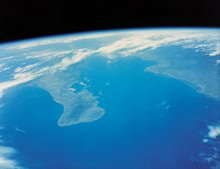
Geothermal heat is melting the ice caps.
A study published today, January 20, 2008, reveals the probable main source of the receding ice caps and climate change. The study by the British Antarctic Survey (BAS) showed the proof of a massive volcanic eruption that melted a large portion of ice shelf some 2000 years ago. The study speculates that the subterranean heating is still on going in this present day and calls for more extensive studies.
The location of the volcano is close to the Pine Island Glacier, the same area experiencing the greatest ice sheet LOSS today!!
To read a summary of the study:
Article Titled:
A recent volcanic eruption beneath the West Antarctic ice sheet
By Hugh F. J. Corr & David G. Vaughan
Published online January 20, 2008
http://www.nature.com/ngeo/journal/vaop/ncurrent/abs/ngeo106.html
This current study backs up the previous reports such as the following:
ANTARCTICA - no name volcano
June 20th, 2004
A previously unknown underwater volcano has been discovered off the coast of Antarctica, and explains mariners' historical reports of discolored water in the area. The research vessel Lawrence M. Gould (information sheet illustrating the ship ) was returning from a study of a collapsed ice self when it passed over the volcano. Temperature probes showed evidence of geothermal heating of seawater. A lack of marine life on dark rock around the volcano indicated that lava had flowed fairly recently. The volcano is in an area known as Antarctic Sound, at the northernmost tip of Antarctica. There is no previous scientific record of active volcanoes in the region where the new peak was discovered. The volcano is located on the continental shelf, in the vicinity of a deep trough carved out by glaciers passing across the sea floor. The volcano stands 2,300 feet above the sea floor and extends to within roughly 900 feet of the ocean surface.
ANTARCTICA - Erebus Volcano
June 1st, 2004
As of the 1st of June, Mt. Erebus, the southern most volcano in the world, still continues to be the most active volcano in Antarctica. Mt. Erebus (3794 meters above sea level) is classified as a polygenetic stratovolcano. The composition of the current eruptive activity on Mt. Erebus is anorthoclase-phyric tephriphonolite and phonolite, which constitute the bulk of exposed lava flow on the volcano………..
A conspicuous break in slope at approximately 3200 meters is a summit plateau representing a caldera. The summit caldera itself is filled with small volume tephriphonolite and phonolite lava flows. In the center of the of the summit caldera is a small, steep-sided cone composed primarily of decomposed lava bombs and a lag deposit of anorthoclase crystals. It is within this summit cone that the active lava lake continuously degasses (CO2) and periodically erupts. Mt. Erebus located on Ross Island, Antarctica is the world’s southern-most active volcano. Discovered in 1841 by James Ross, it is one of only a very few volcanoes in the world with a long-lived (decades or more) lava lake. Scientific research, sponsored by the U.S. National Science Foundation (NSF) since began the early 1970’s had included basic study of the petrology and geophysics of the volcano, the eruptive history, activity and degassing behavior of the lava lake, and the overall impact of the volcano on the Antarctica and global environment. Research on Mt. Erebus has been primarily conducted by scientists in the Department of Earth and Environmental Science and the Bureau of Geology and Mineral resources at the New Mexico Institute of Mining and Technology.
How inconvenient that this information has not been spread throughout the media to educate people, so that they can plan for the future.
Links:
http://www.antarctica.ac.uk/press/press_releases/press_release.php?id=341 BAS
http://www.usap.gov/vesselScienceAndOperations/images/PRVPoster-3x4.jpg Ship Information



No comments:
Post a Comment